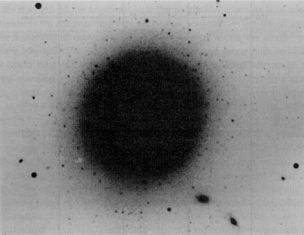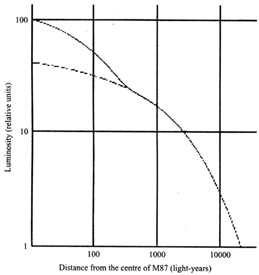

© CAMBRIDGE UNIVERSITY PRESS 1999
| |
1.5 Physical Characteristics: Active Galactic Nuclei
In Figure 1.2 we see an optical photograph of the galaxy M87. This galaxy is of Hubble type E0, with the peculiar feature that again a jet appears to come out of it. The emergence of the jet is an indication of some violent activity in the nucleus, which, as mentioned above, is of an exceptional nature in the context of galaxies. Normally one would expect that more stars would congregate towards the galactic centre, which might lead to greater velocity dispersion and greater brightness compared to the outer regions. However, when in the late 1970s, with one of the early uses of charge coupled device (CCD) cameras, the nucleus of M87 was looked at more closely, it showed a sharp rise in the luminosity towards the centre (see Figure 1.3). This rise could be explained by supposing that there is a massive attractor at the centre, which pulls a large population of stars into a compact region, thereby pushing up the luminosity of the region.

|
Fig. 1.2. The galaxy M87 at optical wavelengths. Reproduced from The Cambridge Atlas of Astronomy, second edition (1988). |

|
Fig. 1.3. The luminosity profile of M87. Reproduced from Narlikar (N96). |
Around the same time the velocity dispersion of stars in the nuclear
region was also measured and it also seemed to rise rapidly inwards.
This too suggested the presence of a massive object in the
nucleus. The conclusion from both these studies was that this central
attractor may well be a massive black hole of ~ 5 x 109
M . The galaxy
M87 is also a strong emitter of X-rays and thus
requires an energy
production mechanism that goes beyond the typical stellar energy
production found in normal galaxies.
. The galaxy
M87 is also a strong emitter of X-rays and thus
requires an energy
production mechanism that goes beyond the typical stellar energy
production found in normal galaxies.
There is thus a similarity between the nucleus of M87 and a quasar-like 3C 273, in that both are seats of intense energy production, both require a collapsed massive object, both are X-ray sources and, in this particular case, both have jets issuing from the central region. As has become clearer over the years, there is a whole class of galactic nuclei of this kind that show signs of energetic activity. These are collectively referred to as active galactic nuclei (AGN).
Indeed, a class of galaxies originally studied by C. Seyfert show the unusual quasar-like feature of emission lines from their centres. Seyfert galaxies, as these galaxies are called, probably form no more than ~ 2 per cent of the class of spiral galaxies. The Seyferts are further subdivided into two classes, Seyfert 1 and Seyfert 2, depending on the width of the emission lines found in them. The distinction made in the literature between a quasar and a Seyfert 1 nucleus is largely morphological: in the latter a galactic envelope is seen whereas a quasar is generally star-like, without a nebulosity.
Indeed, the strength of the argument that the redshift of a quasar is of cosmological origin rests mainly on the continuity of properties between Seyfert nuclei and quasars. It should be remembered that most Seyferts are known within the nearby region and therefore have low redshifts, whereas quasars are, by and large, high redshift objects. Arguments could be made either way on this distinction. Thus one could argue that a quasar has manifestly different morphology from a Seyfert and this generates an extra intrinsic redshift. Or, one could argue that if we look at a very distant Seyfert, its galactic envelope would be very faint and would be outshone by its bright nucleus, which is what a quasar is.
The conventional view is the latter of the above two and regards quasars and AGN as different manifestations of the same basic phenomena. In the following chapters we shall subscribe to this view and develop the astrophysics of these remarkable objects using the cosmological hypothesis. Only when we get to Chapter 15 shall we take a critical look at the cosmological hypothesis and the evidence claimed for and against it.
As the starting point of the hypothesis we outline the expanding universe paradigm in the following chapter.